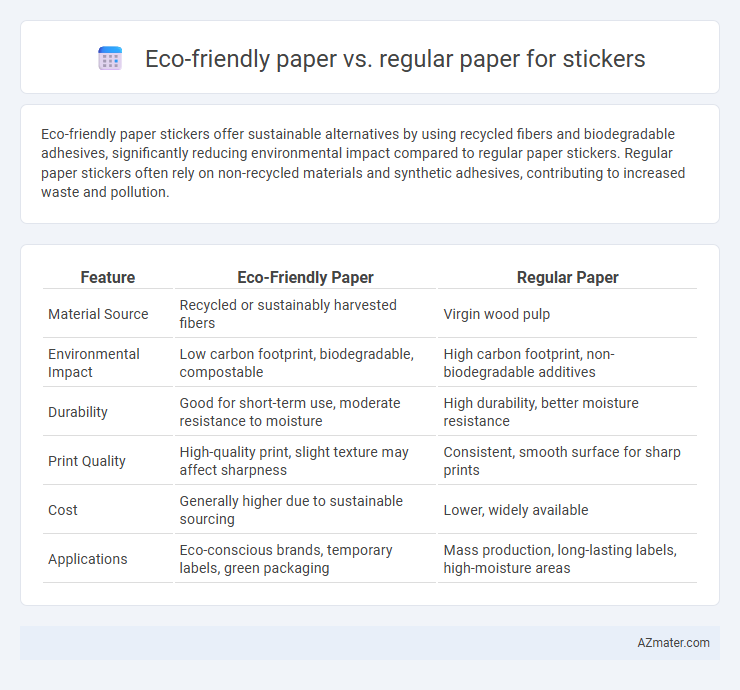Eco-friendly paper stickers offer sustainable alternatives by using recycled fibers and biodegradable adhesives, significantly reducing environmental impact compared to regular paper stickers. Regular paper stickers often rely on non-recycled materials and synthetic adhesives, contributing to increased waste and pollution.
Table of Comparison
| Feature | Eco-Friendly Paper | Regular Paper |
|---|---|---|
| Material Source | Recycled or sustainably harvested fibers | Virgin wood pulp |
| Environmental Impact | Low carbon footprint, biodegradable, compostable | High carbon footprint, non-biodegradable additives |
| Durability | Good for short-term use, moderate resistance to moisture | High durability, better moisture resistance |
| Print Quality | High-quality print, slight texture may affect sharpness | Consistent, smooth surface for sharp prints |
| Cost | Generally higher due to sustainable sourcing | Lower, widely available |
| Applications | Eco-conscious brands, temporary labels, green packaging | Mass production, long-lasting labels, high-moisture areas |
Understanding Eco-Friendly Paper and Regular Paper
Eco-friendly paper for stickers is typically made from recycled materials or sustainably sourced fibers, reducing environmental impact through lower energy consumption and decreased chemical use during production. Regular paper, often derived from virgin pulp and bleached with harsh chemicals, contributes to deforestation and higher carbon emissions. Choosing eco-friendly paper enhances sustainability by promoting biodegradability and reducing landfill waste compared to conventional sticker paper.
Environmental Impact of Sticker Materials
Eco-friendly paper for stickers significantly reduces environmental impact by using sustainable sources, lower water consumption, and fewer chemicals compared to regular paper. Regular paper often relies on non-recycled pulp and chlorine-based bleaching, contributing to deforestation and water pollution. Choosing eco-friendly sticker materials supports reduced carbon footprint and promotes recyclability and biodegradability.
Production Process: Eco-Friendly vs Regular Paper
Eco-friendly paper for stickers is produced using sustainable raw materials such as recycled fibers, agricultural waste, or certified wood pulp, significantly reducing deforestation and water consumption compared to regular paper. Its manufacturing process employs eco-conscious bleaching agents and minimal chemical additives, lowering harmful emissions and energy use in contrast to conventional paper production, which often relies on chlorine-based bleaches and intensive chemical treatments. This sustainable approach not only lessens the environmental footprint but also supports circular economy principles in the sticker production industry.
Biodegradability and Compostability
Eco-friendly paper stickers significantly outperform regular paper in biodegradability, breaking down naturally within weeks to months without leaving harmful residues. Compostability of eco-friendly paper stickers allows them to be safely integrated into industrial or home composting systems, enriching soil without releasing toxins. In contrast, regular paper stickers often contain synthetic adhesives and coatings that hinder breakdown and prevent safe composting.
Resource Consumption and Sustainability
Eco-friendly paper for stickers significantly reduces resource consumption by using recycled fibers and sustainable materials, minimizing deforestation and water usage compared to regular paper. It typically involves lower energy consumption during production and incorporates eco-conscious adhesives, enhancing the overall sustainability of the product. Choosing eco-friendly paper supports circular economy practices by enabling recycling and biodegradability, which regular paper often lacks due to chemical treatments and synthetic coatings.
Print Quality and Durability Comparison
Eco-friendly paper for stickers often features a matte finish with lower opacity, which can slightly reduce print vibrancy compared to the high-gloss surface of regular paper that enhances color sharpness and contrast. Durability-wise, eco-friendly paper typically uses less plastic lamination, resulting in lower water and scratch resistance than the heavily coated regular paper designed for long-lasting adhesion and wear. Print quality on eco-friendly materials suits natural, muted designs, while regular paper excels in delivering crisp, bold graphics with superior resilience for outdoor or heavy-use applications.
Cost Analysis: Upfront and Long-term
Eco-friendly paper for stickers typically has a higher upfront cost due to sustainable sourcing and production processes, averaging 15-30% more than regular paper. Over the long term, eco-friendly paper reduces expenses related to waste management and aligns with growing consumer demand for sustainable products, potentially increasing brand loyalty and market share. Conversely, regular paper remains cost-effective initially but may incur higher environmental compliance fees and damage brand reputation in sustainability-conscious markets.
Availability and Sourcing
Eco-friendly paper for stickers is often sourced from sustainably managed forests or recycled materials, ensuring reduced environmental impact and compliance with certifications like FSC or PEFC. Availability can vary regionally, with eco-friendly options sometimes limited to specialty suppliers compared to the widespread distribution of regular paper, which is mass-produced from virgin pulp. Brands prioritizing sustainability increasingly enhance the supply chain for eco-friendly sticker paper, improving accessibility while maintaining quality and environmental standards.
Consumer Preferences and Market Trends
Eco-friendly paper for stickers appeals to environmentally conscious consumers seeking sustainable alternatives, often influencing purchasing decisions based on biodegradability and recyclability. Market trends indicate a growing demand for eco-friendly paper, driven by increased awareness of environmental impact and brand commitments to sustainability. Regular paper remains popular due to lower costs and widespread availability, though its use is declining as consumers prioritize green products in sticker production.
Making the Greener Choice for Stickers
Eco-friendly paper for stickers, made from recycled fibers or sustainably sourced materials, significantly reduces environmental impact compared to regular paper, which often relies on virgin pulp and chemical-heavy processes. Choosing eco-friendly paper supports lower carbon footprints and less deforestation, while maintaining strong adhesive compatibility and print quality for vibrant, durable stickers. Opting for biodegradable or compostable sticker paper furthers waste reduction efforts, making it the greener choice for environmentally conscious brands and consumers.

Infographic: Eco-friendly paper vs Regular paper for Sticker
 azmater.com
azmater.com